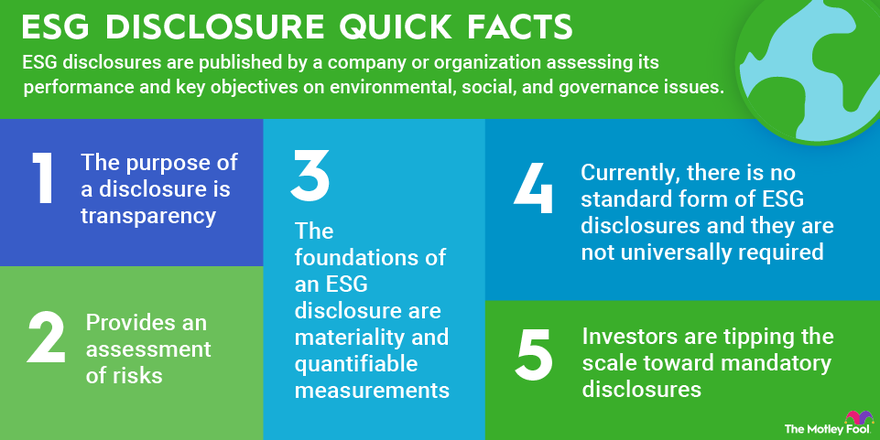ESG disclosures are an investment tool on the rise. Environmental, social and governance disclosures are reports that comprehensively assess a company’s long-term strengths and weaknesses related to ESG risks.
Evaluating a company’s long-term financial health by assessing potential risks is an important step in screening stocks and building risk-appropriate portfolios. Businesses that meaningfully integrate ESG disclosures into strategic planning are better positioned to deliver increased shareholder value and resilience in a changing world.

Although financial analysis and assessment are a constant part of the investment process, ESG has also proved to be a valuable indicator of long-term, sustainable financial success. Investors are flocking to ESG investing and analyzing ESG ratings and ESG disclosures to improve their understanding of a company’s long-term outlook.
Below, we’ll cover what’s included in an ESG disclosure and the major ESG frameworks that guide those disclosures.
What is ESG and why is it important?
ESG is a measure of a company's commitment to people and the planet. ESG can also be a powerful opportunity for long-term, profitable growth. All companies face risks related to climate change, social injustice or poor working conditions, and governance. Companies that actively manage the risks through ESG initiatives should have an advantage over those that don't.
- Environmental risks can include climate change vulnerabilities, water scarcity risks, or exposure to carbon emissions regulations.
- Social risks can include worker safety issues, lack of fair wages, or mistreatment of overseas workers.
- Governance risks can include a lack of transparency in accounting or financial practices, a lack of board diversity or representation, or excessive executive compensation.
What is an ESG disclosure?
ESG disclosures define and assess a company's environmental, social, and governance risk. The disclosures also explain how the company intends to mitigate risks and outline concrete steps to implement further ESG strategies.
The purpose of an ESG disclosure is to provide stakeholders with transparency into long-term risk factors.
There is currently no standard form of ESG disclosure. This is problematic on two levels. One, companies can publish ESG disclosures that highlight their strengths and de-emphasize their weaknesses. And two, without standardized reporting, investors can't easily compare ESG performance from one company to the next.
Fortunately, the lack of standardization is likely to change, thanks to demands from investors, stakeholders, and agencies. Intergovernmental and non-governmental organizations have developed various reporting frameworks, which some companies are using. The International Sustainability Standards Board (ISSB) is also working on a more comprehensive reporting that may become a requirement in 2024.
ESG disclosures define and assess a company's environmental, social, and governance risk.
International Sustainability Standards Board
In November 2021, the International Financial Reporting Standards Foundation (IFRS) announced the establishment of an International Sustainability Standards Board (ISSB) to develop comprehensive sustainability disclosure standards to meet investor need for actionable ESG information.
The International Sustainability Standards Board now sits alongside the International Accounting Standards Board to develop global standards and provide a baseline of sustainability information.
The ISSB consolidates earlier ESG disclosure standards, including the Climate Disclosure Standards Board (CDSB), the Value Reporting Foundation, the Global Reporting Initiative (GRI) Standards, and the Sustainability Accounting Standards Board (SASB) Standards.
Each disclosure framework provides a unique lens for information. The GRI standards focus on environmental, economic, and social impacts of a company in relation to sustainable development. The SASB standards focus on sustainability issues expected to have a financially material impact on a company. Taken together, the ISSB reporting standards simplify and standardize ESG disclosures and reporting.
The disclosure requirements enable companies and organizations of all sizes to understand and report their impact on the environment, people, and the economy in a way that is transparent, credible, and comparable for investors and stakeholders. The standards also allow companies to create a comprehensive picture of their material topics, impacts, and how they are managing them.
What's included in an ESG disclosure?
The foundations of an ESG disclosure are materiality and quantifiable measurements. Good intentions are often met with frustration if intentions are not backed by concrete implementation using specific, measurable targets. Here’s how to apply them to ESG disclosures:
Materiality
Materiality is the measure of the relative importance of performance on key metrics. Materiality is measured differently for ESG disclosures than in standard accounting practices. In accounting, materiality refers purely to financial performance. In ESG disclosures, materiality is any measure that has significant impact for stakeholders.
In an ESG disclosure, stakeholders are defined by each company and can include individuals or companies with an interest in the business, investors, employees, the community, or even the environment. In this sense, materiality takes a broader scope.
Materiality asks these questions:
- Who are the stakeholders?
- What is important to them?
- Why?
Impact materiality
Impact materiality is the broadest measure of materiality within the ESG disclosure framework. Impact materiality captures significant effects of a company on the environment, people, society, or the economy that are not seen in enterprise value. Impact materiality looks at an organization’s impact -- both positive and negative -- toward overall sustainable development.
Financial materiality in the context of sustainability
For investors, SASB standards now under the ISSB take a narrower view by providing insight into a company’s financial materiality in the context of sustainability factors. SASB standards look at how sustainable factors affect a company’s value in the short, medium, and long term.
Investors can use SASB’s materiality finder for a visual representation of their total portfolio’s exposure to sustainability risks and opportunities. For organizations, SASB metrics are already aligned with reporting standards and existing metrics whenever possible, including major industry organizations, to simplify report preparations.
Quantifiable measurements
Arguably the most critical aspect of an ESG disclosure is the quantification of ESG steps deemed material to key stakeholders. Even a company’s target to be 100% carbon-neutral by 2050 will likely be criticized as greenwashing without implementation steps and measurable landmarks.
To show measurable progress, ESG reporting requires initial measurements and defined reporting milestones. Reporting periods can vary based on goals, measurements, and industries -- but investors generally prefer annual disclosures.
When noting quantifiable measurements, ESG reporting standards can be either universal standards applicable to any organization or sector-specific. Sector-specific standards allow for more consistent reporting on industry-specific impacts.
ESG disclosure frameworks
While there's no universal ESG disclosure framework today, the ISSB is working to change that. The organization is currently working on two drafts that would require comprehensive ESG reporting:
- IFRS S1 General Requirements for Disclosure of Sustainability-related Financial Information outlines requirements for companies to report on their risks related to sustainability.
- IFRS S2 Climate-related Disclosures defines how companies should identify, measure, and disclose their climate-related risks.
The ISSB proposes that the drafts become effective for reporting periods that begin on or after Jan. 1, 2024. To be clear, the Securities and Exchange Commission -- not the ISSB -- sets reporting rules for U.S. public companies. The SEC isn't likely to adopt the ISSB reporting standards, but may define its own.
It's more likely the SEC will impose standardization on ESG ETFs first. Some of the funds have exaggerated their ESG profiles, becoming examples of greenwashing.
In the meantime, companies can lean on disclosure recommendations from other organizations. Some of the more prominent ESG disclosure standards are introduced below.
Global Reporting Initiative (GRI) Standards
GRI is the most widely used international independent ESG standard for comprehensive reports and selected disclosures. GRI provides standards of disclosure for companies to communicate information on ESG issues including climate change, human rights, governance, and social well-being.
Sustainability Accounting Standards Board (SASB) Standards
SASB offers a framework of accounting standards and disclosures to support public companies in reporting material, actionable, and relevant ESG information to investors in their mandatory filings. Activities are grouped into five dimensions of sustainability: Environment, human capital, social capital, business model and innovation, and leadership and governance.
SASB offers 77 industry-specific sets of standards. SASB has already consolidated several other reporting frameworks into its standards, including the International Integrated Reporting Council (IIRC), to improve ease of reporting and comparable data frameworks.
United Nations Principles for Responsible Investing (PRI)
The UN PRI works to promote ESG factors into investment decision-making. PRI includes possible actions for incorporating ESG issues into investment practices and reporting and assessment tools for corporations.
CDP Global (formerly the Carbon Disclosure Project)
CDP Global is an international non-profit organization aiming to encourage investors, companies, and governments to make choices for a sustainable economy. Its environmental disclosure platform collects standardized information from companies on climate change and the use of natural resources such as water.
Global ESG Disclosure Standards for Investment Products (CFA Institute)
The CFA Institute’s standards aim to help investors, consultants, advisors, and distributors understand, compare, and evaluate investment products, while diminishing the potential for greenwashing through standardized disclosures.
Are ESG disclosures required?
ESG disclosures are not universally required, but that doesn’t mean corporate boards should ignore them. The tide is turning, and companies would be well-served to stay ahead of the trend.
Digital communication and the prominence of environmental and social crises around the world are reshaping public demand from investors and consumers. ESG disclosures provide opportunities for companies to protect and build business value.
The International Organization of Securities Commissions (IOSCO) has noted the crucial role of the financial sector in supporting the transition to a more sustainable future and the need for investors to have comparable ESG data.
At least 15 of the G-20 nations require some structure of mandatory corporate reporting for climate-related risks and opportunities. The European Union has one of the most comprehensive disclosure frameworks. It requires large companies to publish reports on policies related to environmental protection and social responsibility, including employee treatment, human rights, anti-corruption, bribery, and diversity on company boards.
SEC Chairman Gary Gensler has supported a mandatory climate risk disclosure proposal and suggested moving with urgency on the new rule. Under the proposal, the disclosures would be provided to investors via structured data that is easily comparable.
The proposed SEC disclosures would require some companies to disclose emissions from upstream or downstream activities in their value chain if the emissions are material to investors. That means that major companies, including Amazon (AMZN 3.2%), could soon be required to disclose total carbon emissions, among other things.
Related investing topics
ESG disclosure framework FAQs
What is an example of ESG disclosures?
Apple (NASDAQ: AAPL) publishes a comprehensive ESG report, which you can view here. Apple also produces an ESG index, which maps its disclosures to metrics outlined in these voluntary disclosure frameworks: Global Reporting Initiative (GRI), Sustainable Accounting Standards Board (SASB) and the Task Force on Climate-Related Financial Disclosures (TCFD). For another disclosure example, see this ESG Summary Report from Walmart (NYSE: WMT).
Are companies required to disclose ESG?
U.S. public companies are not currently required to disclose ESG risks and initiatives.
How do companies disclose ESG?
Companies voluntarily disclose their ESG risks and initiatives. This is commonly in the form of an annual report, which may be called a sustainability report, ESG report, or impact report. You can typically find these reports in the investor relations section of the company's website.
The bottom line on ESG disclosures
Investors and major securities exchanges have seen the material impact that ESG concerns can have on a company’s long-term performance. ESG disclosures can be one more assessment tool for investors, especially when produced within one of the frameworks mentioned above.
Companies of all sizes would benefit from creating an ESG disclosure and setting new ESG targets to build investor confidence. The time of universally agreed-upon ESG disclosures is not far away. The International Sustainability Standards Board is positioned to change the landscape of ESG disclosures with reliable, quantifiable, and comparable ESG data.
For investors who want to get started right away, here are 10 of the best ESG stocks with excellent records on both historical performance and ESG commitment.


















